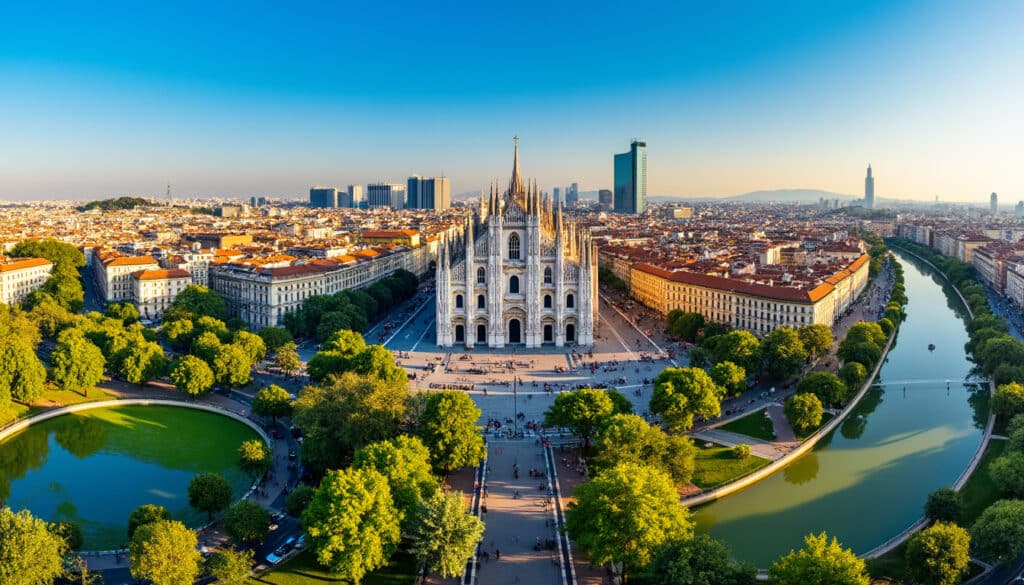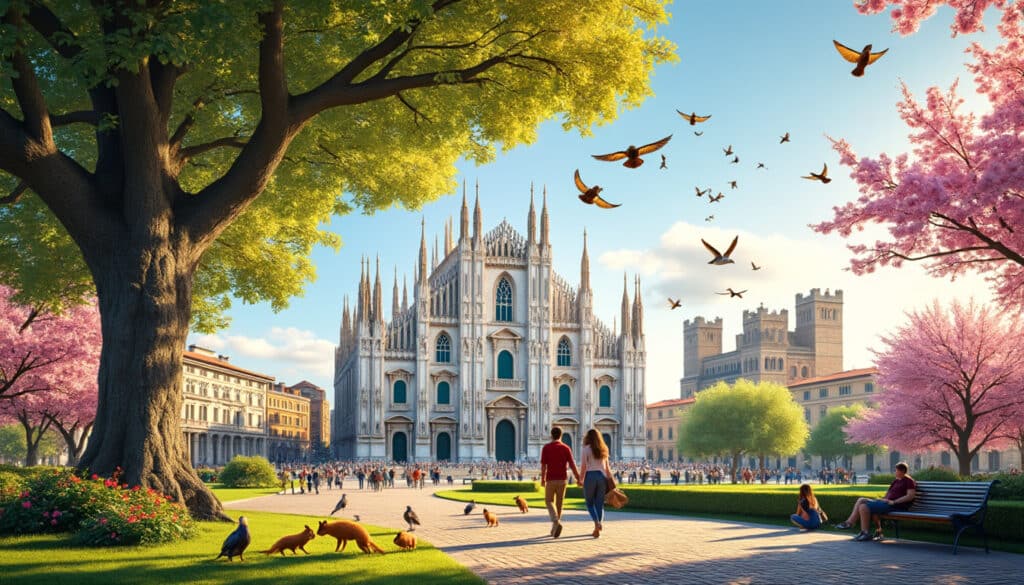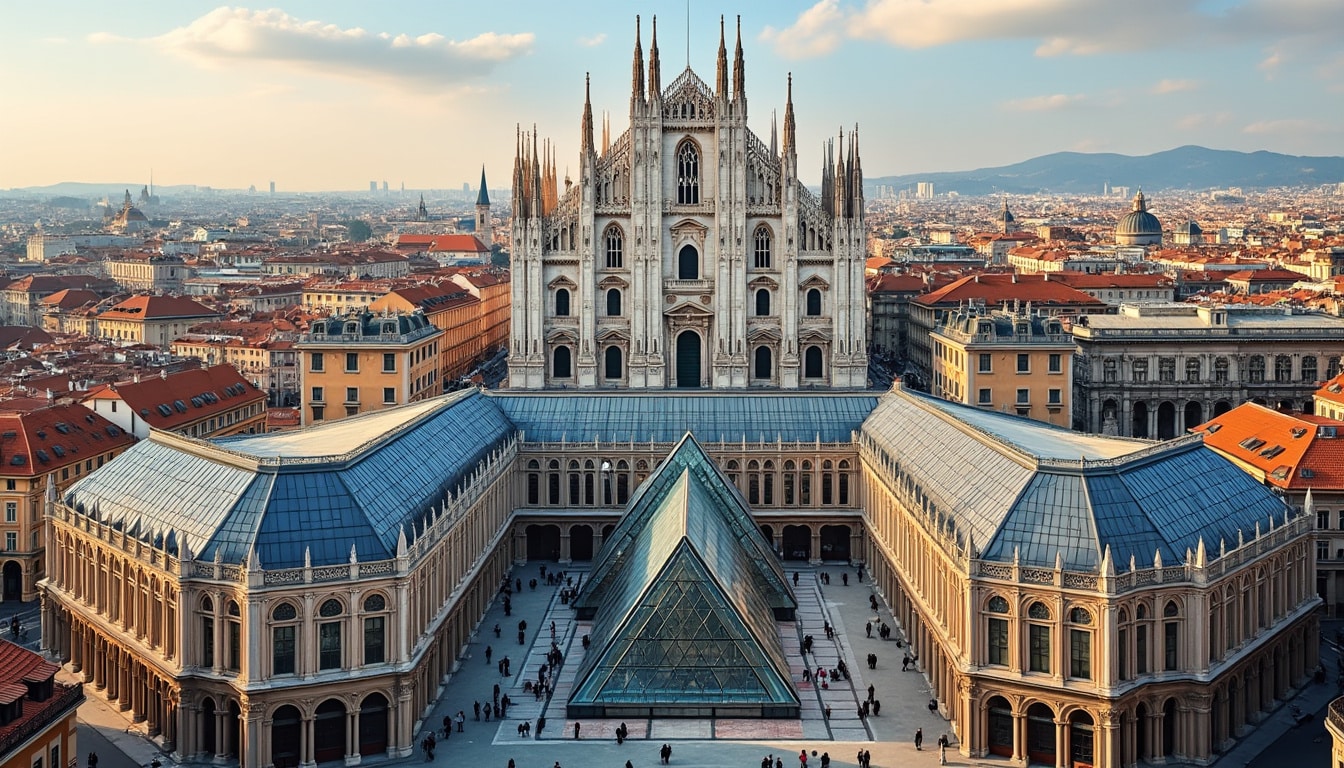Discover the rich tapestry of Milan, a city celebrated for its blend of modernity and tradition. Ever wondered where exactly this fashion metropolis is located on the globe? This article delves into the geographic coordinates and pivotal elements that shape Milan as a thriving urban center. With its strategic positioning in northern Italy, this vibrant city beckons travelers, investors, and urban planners alike. From understanding its precise location via geographic coordinates to exploring its real estate potential and urban planning, this exploration of Milan is both comprehensive and insightful.
Understanding the Geographic Coordinates of Milan
Milan sits comfortably in northern Italy, known for its historic influence on global fashion and economy. The city’s location is defined by several geographic coordinates, notably a latitude of 45.4643° N and a longitude of 9.1895° E. This positioning places Milan firmly within the Lombardy region. Lombardy is not just another region but a vital economic powerhouse of Italy, significantly contributing to the nation’s GDP. Its elevation is approximately 400 feet above sea level, offering a mix of flat and slightly hilly terrains.
Geographic coordinates are more than arbitrary numbers—they serve as vital tools for navigation and urban planning. In Milan, these coordinates are of great importance for urban planners aiming to sustain the city’s growth while preserving its rich cultural heritage. Moreover, these figures are utilized not only in mapping but also in the Global Positioning System (GPS), an essential tool for anyone seeking to travel the intricate streets of Milan.
Here’s a structured breakdown of Milan’s geographic location:
| Feature 🌍 | Detail 📍 |
|---|---|
| Latitude | 45.4643° N |
| Longitude | 9.1895° E |
| Elevation | 400 feet |
This precision aids real estate developers, environmental planners, and businesses in leveraging Milan’s position, making it an attractive locale for investment and tourism. The realistic application of these coordinates shows Milan’s accessibility through various means of transport, including the three significant airports: Malpensa, Linate, and the nearby Orio al Serio. So why not plot your next journey around Milan using these geographic markers? Your itinerary can include iconic landmarks like the Milan Cathedral, Galleria Vittorio Emanuele II, and the prestigious La Scala opera house, all easily navigated through GPS precision.

The Vibrant Heartbeat of Milan’s City Center
At the center of this urban marvel lies Piazza del Duomo, the epicenter of cultural and commercial life in Milan. The square itself is a geographical landmark, marking the zero point for all distances in Milan, akin to a city within a city. Surrounding it are several attractions that offer insights into the fascinating blend of ancient and modern architectural styles.
One must-visit spot is the Milan Cathedral, a stunning gothic masterpiece that took nearly six centuries to complete. Just a stone’s throw away is the Galleria Vittorio Emanuele II, showcasing Milan’s entrepôt status with luxury retailers and refined Italian eateries.
Beyond its grand facades, Milan holds secret passages within its historical core, with neighborhoods like Brera and Navigli offering artistic vibes with their studios and galleries. Here’s a list of must-see attractions in the heart of Milan:
- 🏛️ Milan Cathedral (Duomo): An architectural wonder with a panoramic rooftop view.
- 🛍️ Galleria Vittorio Emanuele II: A shopper’s paradise dating back to the 19th century.
- 🎨 Brera District: Art galleries and historical charm.
- 🛶 Navigli Canals: Picturesque waterways with livened night corridors.
- 🎭 La Scala Opera House: Music enthusiasts’ haven for world-class performances.
Tracking these locations with ease could revolutionize how tourists and locals enjoy Milan’s strategic urban planning layout. Have you ever wondered how historical heritage coexists with modern development? Thanks to progressive urban planning, Milan remains a dynamic city retaining historical integrity while embracing modern advancements. Want to learn more about what makes their approach so special? Check out this comprehensive guide on Milan’s geographical features.
Travel and Tourism: Navigating Milan’s Urban Landscape
Tourism is a vital component of Milan’s identity, with millions of visitors arriving annually to experience its glamour and allure. Navigating Milan, however, requires an understanding of its coordinates and comprehensive urban layout—a fusion of old-world charm and neon-city elegance.
Milan’s transportation network integrates modern infrastructure, ensuring seamless navigation. The city’s extensive metro system, operated efficiently under holiday openings, supports both residents and tourists, linking every corner of the metropolis.
Head to greater Milan and you’ll uncover hidden gems off the beaten path. The urban nodes of this metropolis, such as Porta Nuova’s skyscrapers, are reshaping the skyline, and serene parks like Sempione and the design districts offer diverse experiences.
For an organized tour, join locals and cosmopolitan travelers alike on the numerous walking tours available. These explorations offer rich narratives of Milan’s historical, architectural, and cultural evolution. Not sure where to start? Consider these itineraries:
- 🚶♀️ Historical Milan: Begins at Piazza del Duomo and expands to La Scala.
- 🚅 Architectural Tour: Features modernist and neoclassical structures.
- 🖼️ Artistic Journey: Traverse through Brera’s galleries and literary cafes.
- 🌳 Green Milan: Explore city parks and ecological spots.
Embrace the top-tier fashion houses of the Quadrilatero d’Oro district, or let your taste buds savor Milanese cuisine in an array of chic trattorias. For more on practical travel advice and insights on navigating this cityscape, enhance your navigational knowledge with GPS aids.
Real Estate and Urban Planning in Milan
In the realm of real estate, Milan stands out as an enticing destination thanks to its strategic location and dynamic economy. Over recent years, the city has witnessed rapid developments, making Milan’s real estate market one of the most stable in Europe. Whether you’re looking to invest in property, relocate, or simply curious about urban living, understanding the geographical context is crucial.
Urban planning in Milan focuses heavily on sustainability and innovation. This approach ensures that the city accommodates its growing population and infrastructure while maintaining its historical charm. Key areas of interest include:
- 🏙️ Porta Nuova: A stunning urban renewal project with modern amenities.
- 🌿 CityLife District: Boasts eco-friendly skyscrapers and expansive parks.
- 🏢 Bicocca District: Known for its contemporary business hubs and educational institutions.
Connectivity is a forethought in Milan’s urban design, with well-structured transport links ensuring seamless movement around the city. Future projects, such as smart city innovations, continue to shape Milan’s landscape, making it a beacon of modern urban planning and an exemplar in sustainable urban development.
To navigate through Milan’s real estate potential, agents often rely on geolocation data that highlights prime districts optimal for residential and commercial growth. Delve deeper into this topic: real estate success stories abound here, where urban planning meets seamless living.
The Role of GPS in Milan’s Navigation and Lifestyle
In today’s tech-driven era, GPS has not only enhanced how we locate places but also transformed lifestyle conveniences worldwide, Milan embracing this advanced technology. Knowing Milan’s coordinates, you’re merely a click away from an unmatched travel experience, revealing even the city’s secluded spots.
GPS systems have streamlined every aspect of daily commuting, helping residents find the best routes while tourists explore new locales with ease. Eager to discover this firsthand? Utilize apps and digital services extensively available in Milan equipped with the latest navigation tools, ensuring quick location pinpoints within urban spreads.
With transport routes optimized, GPS aids in real time traffic updates, delivering accurate directions, enabling Milan’s dynamic city life to become increasingly accessible. Planning on embarking on a journey exploring the breadth of this metropolis? Here’s how GPS enriches your travels:
- 📱 Automobile Navigation: Optimal pathfinding reduces travel confusion.
- 🏃♂️ Pedestrian Routes: Walking directions lead to historical cites and hidden alleys.
- 🚴♀️ Cycle Paths: Guides pedal-enthusiasts safely with innovative route mapping.
- 🛡️ Safety Features: Emergency guidelines and asset securitization.
Whether it’s aligning travel plans, identifying real estate opportunities, or enhancing urban living, Milan’s adept use of GPS serves residents and tourists magnificently. To dive into the world of digital navigation and related resources, you might explore more insights here.
FAQ
- What are Milan’s geographic coordinates?
Milan is located at 45.4643° N latitude and 9.1895° E longitude.
- How does one navigate Milan using GPS?
GPS systems and apps provide real-time navigation, traffic updates, and pedestrian guides throughout the city.
- Why is Milan significant in real estate?
Its strategic location, economic stability, and innovative urban planning make Milan a lucrative real estate market.
- What makes Milan an attractive tourist destination?
A harmonious blend of historical landmarks, vibrant neighborhoods, and cultural richness draws millions of visitors annually.

Milan, nestled in the heart of northern Italy, is renowned not only for its vibrant fashion scene and historical architecture but also for its unique geographical landscape and natural environments. At first glance, Milan appears to be a bustling urban…

Geographical features of Milan
Milan, Italy’s bustling cosmopolitan hub, is a city of remarkable contrasts and rich history. Known for its fashion prowess and cultural landmarks, the city’s geographical features offer a fascinating backdrop to its urban splendor. Set in the expansive Po Basin…

🌿 Milan, a city globally acclaimed for its rich tapestry of fashion, art, and architecture, also conceals an awe-inspiring realm of nature and wildlife. This paradoxical urban jungle promises an exhilarating escapade into lush termini where nature enthusiasts can discover…


